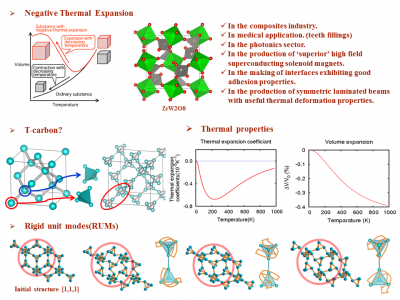Lab Introduction
Members' Pages
Principal Investigator
Research Professor
Ph.D. Students
M.S. Students
Undergraduate Students
- Kang Il Cho
- Dong-Oan Seo
Following are other carbon materials we have investigated for their properties and applications.
 T-carbon proposed first in 2011 can be made from diamond, in which
every carbon atom is replaced with a carbon tetrahedron. We found that
T-carbon exhibits an unusual behavior, negative thermal expansion, for
which rigid unit modes excited in T-carbon are responsible.
T-carbon proposed first in 2011 can be made from diamond, in which
every carbon atom is replaced with a carbon tetrahedron. We found that
T-carbon exhibits an unusual behavior, negative thermal expansion, for
which rigid unit modes excited in T-carbon are responsible.
We have explored the suitability of nanotube-based hooks for bonding. Our results indicate that a large force of 3.0 nN is required to disengage two hooks, which are formed by the insertion of pentagon-heptaon pairs in a (7,0) CNT. Nanohooks based on various nanotubes are resilient and keep their structrual integrity during the opeing process. Arrays of hooks, which are permanetly anchored in solid surfaces, are a nanoscale counterpart of velcro fasteners, forming tough bonds with a capability of self-repair.
 download:
download: 

This micro-fastening system was rigisterd as a US patent (US7,181,811).
 download:
download: 

Using molecular dynamics calculations, we have investigated the absorption of a C60 molecule in a (10, 10) nanotube either through the open and or a large defect in the tube wall as possible scenarios for the hierarchical self-assembly of (C60)n@(10,10 “nano-peapods”. We found the absorption through a defect to be significantly more efficient than the end-on absorption. This process occurs most likely within a narrow launch velocity range for the fullerene that agrees well with the observed optimum temperature window for peapod formation.
 download:
download: 

We have determined the stability, optimun geometry, and electronic properties of nanometer-sized capped graphitic cones, called “nanohorns”. Different nanohorn morphologies were considered, which differe in the relative location of the five terminating pentagons. Simulated scanning tunneling microscopy images of the various structures at different bias voltages reflect a net electron transfer towards the epntagon vertex sites. We found that the density of states at the tip, ovservable by scanning tunneling spectroscopy, can be used to discriminate between different tip structures.
 download:
download: 
